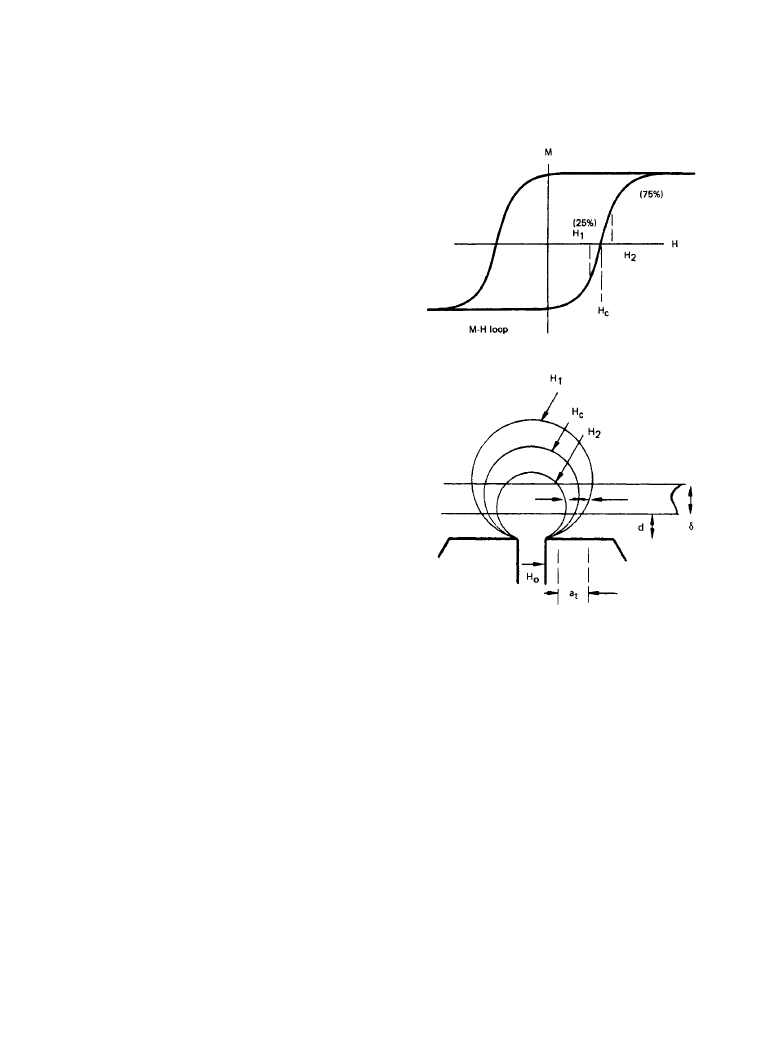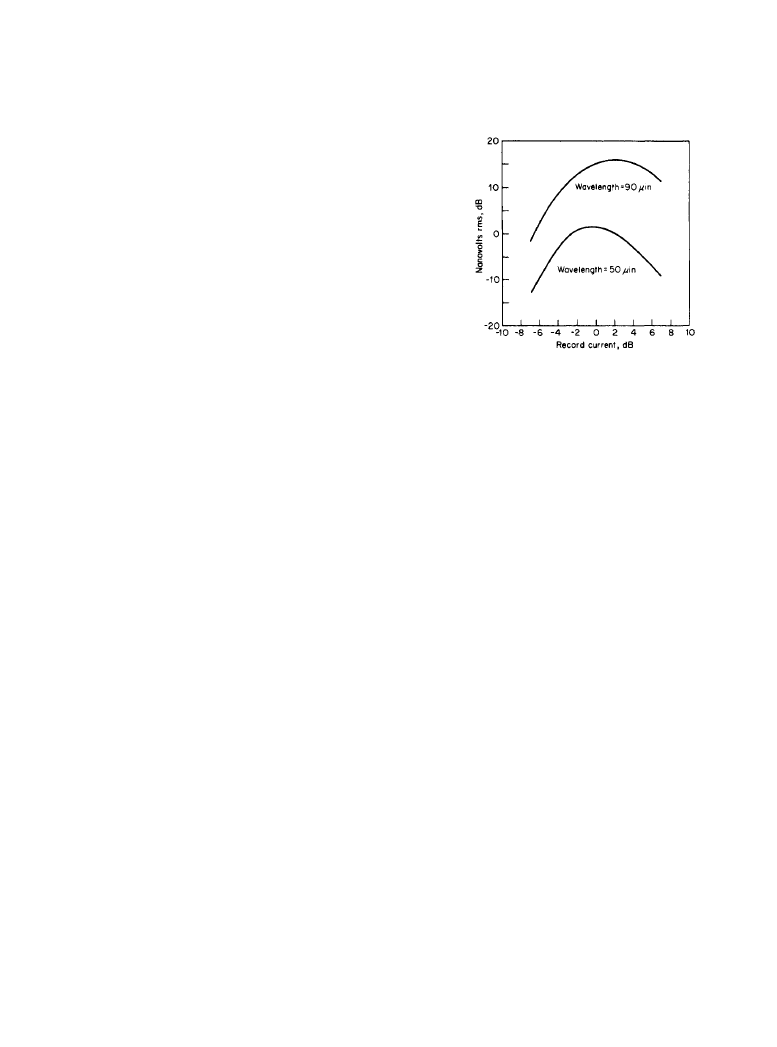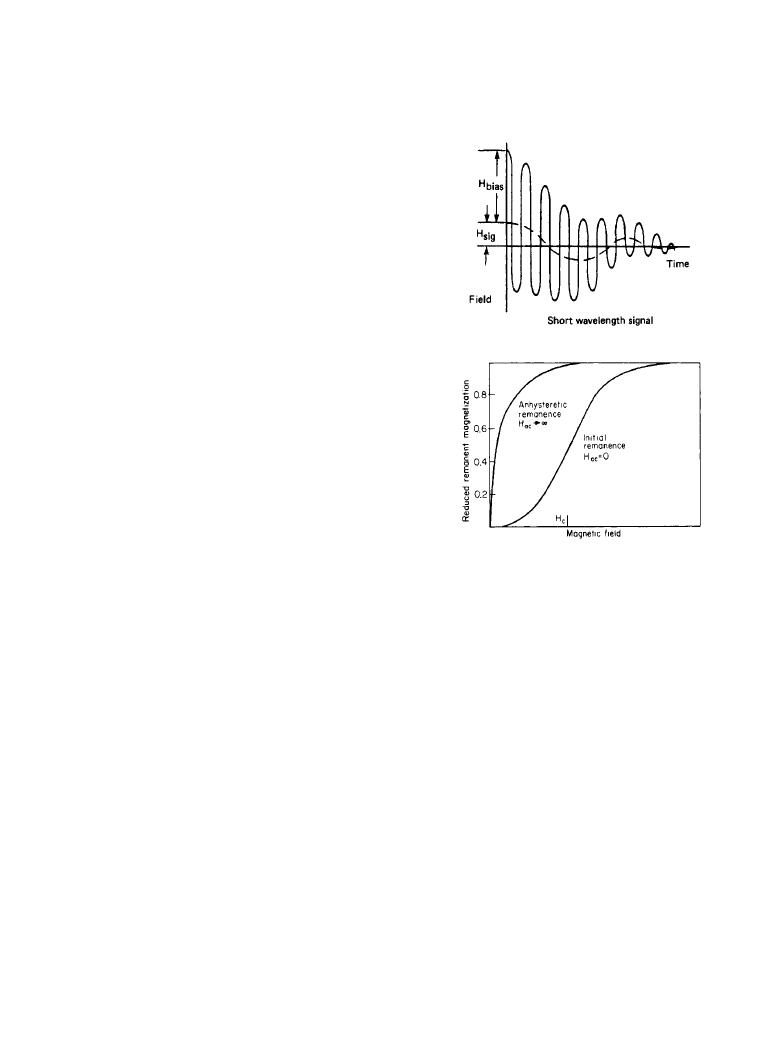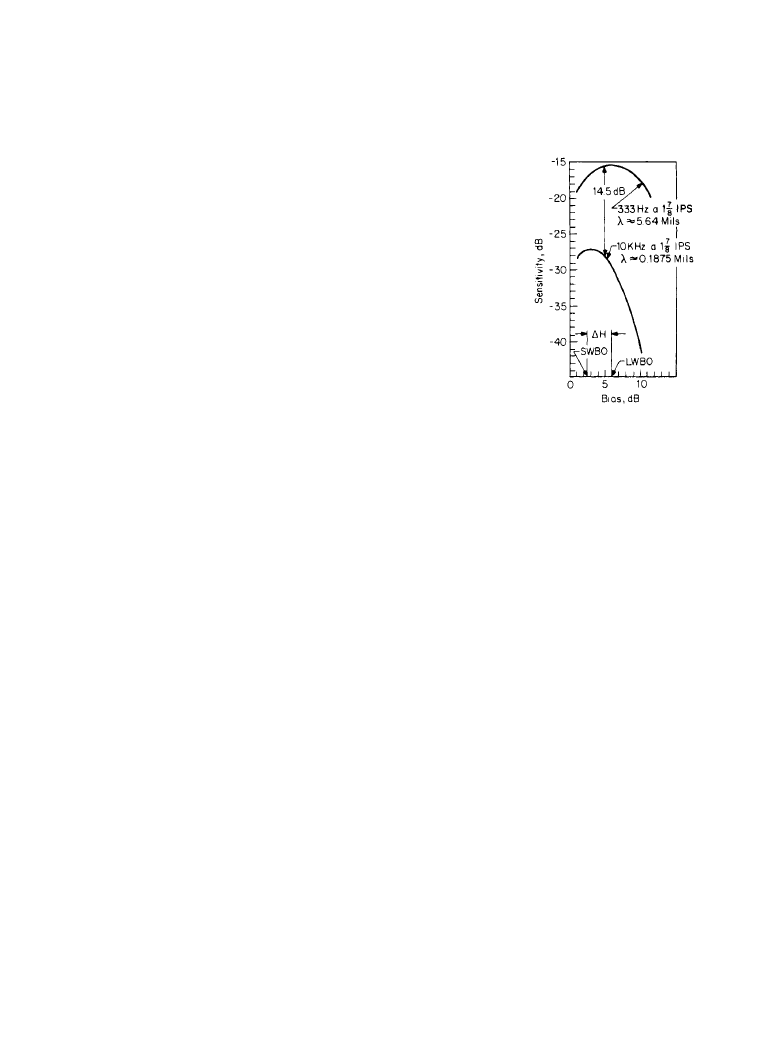ВУЗ: Казахская Национальная Академия Искусств им. Т. Жургенова
Категория: Книга
Дисциплина: Не указана
Добавлен: 03.02.2019
Просмотров: 21714
Скачиваний: 19

9-42 Audio Recording Systems
ity changes of magnetization is due to the finite-loop slope at the coercivity, combined with the
gradual decrease of the head field away from gap center. This process is illustrated in Figures
9.3.3 and 9.3.4. In Figure 9.3.3 the M-H remanence loop is shown for a well-oriented tape sam-
ple. The magnetization M is the remanence magnetization that results from the application of a
field H, which is subsequently removed. If the tape is saturated in one direction, for example, –
M, and a positive field is applied, then the magnetization will start to switch toward the positive
direction when the field is close to the remanent coercivity H
c
r
. Because the slope of this M-H
loop is not infinitely steep for fields near H
c
r
, the switching will take place gradually. H
1
denotes
the field that switches 25 percent of the particles to leave the magnetization at –M/2; H
c
r
is, in
fact, the 50 percent reversing field that leaves M = 0. H
2
denotes the 75 percent switching field
that leaves the magnetization halfway to positive saturation (+M/2). During recording, a finite
transition width will occur, depending on how H
1
and H
2
are spatially separated. In Figure 9.3.4,
three contours of recording field are plotted for the three fields H
1
, H
c
r
, and H
2
. In plots of head
fields, larger fields are closer to the surface of the head and toward the gap center. Thus, along
the midplane of the tape the field magnitudes H
2
, H
c
r
, H
1
are in decreasing order away from the
gap centerline. Therefore, if the tape is initially magnetized negatively, a positively energized
head (H
0
) will switch the magnetization according to Figure 9.3.3 following the spatial change of
Figure 9.3.3
M-H hysteresis loop for a typi-
cal tape.
Figure 9.3.4
Head-field contours showing
recording zone in tape.
Downloaded from Digital Engineering Library @ McGraw-Hill (www.digitalengineeringlibrary.com)
Copyright © 2004 The McGraw-Hill Companies. All rights reserved.
Any use is subject to the Terms of Use as given at the website.
Recording Fundamentals

Recording Fundamentals 9-43
the fields. This yields a finite transition width a
t
. The transition width can be narrowed by using
tape with a steeper loop gradient, making H
1
closer to H
2
in magnitude (a narrower spread in
switching fields) and decreasing the head-to-tape spacing, which moves H
1
and H
2
closer
together spatially (a larger head field gradient) as indicated in Figure 9.3.4. In addition, spatial
changes in magnetization cause demagnetization fields in the tape that further broaden the tran-
sition. This demagnetization broadening can be reduced by increasing the tape coercivity.
In saturation recording, the signal current is held fixed for all wavelengths. The current level
is set to optimize the short-wavelength output, and complete saturation of the tape does not
occur. In Figure 9.3.5 reproduce voltage versus input current is shown for two different wave-
lengths in square-wave recording for video tape (Ampex 196). If true saturation were to occur,
the curves would increase initially with current as the tape is recorded, and then level, represent-
ing a magnetization saturated to full remanence and recorded fully through the tape thickness of
200
µin (5 µm). However, at short wavelengths these curves are peaked, and the current that
yields the maximum output represents recording only a very small distance into the tape. For
video recording on a type C format machine optimized at 10 MHz (
λ ≈ 100 µin), this is a record
depth of approximately 50
µin. A mechanism for optimization of this parameter can be seen by
considering the change in transition with record current. As the current is raised, the point of
recording shifts continuously downstream from the gap center. The transition width depends
upon the head-field gradient at the recording point. This field derivative, H
2
– H
1
, divided by the
separation between them, increases with distance along the head surface, as shown in Figure
9.3.4, reaching a maximum near the gap edge and thereafter decreasing. Because the reproduce
voltage increases with decreasing transition width, a maximum voltage will occur as the current
is increased. This peaking becomes more pronounced as the wavelength is reduced.
A form of linearity known as linear superposition is found in saturation recording. For con-
stant-current recording (strictly, constant-field amplitude) the reproduce voltage from a compli-
cated pattern can be shown to closely resemble the linear superposition of isolated transition
voltage pulses, according to the timing and polarity change of the series of transitions. The lack
of complete linear superposition is believed due to demagnetization fields. This accompanies
large head-to-medium separations, as in rigid-disc applications, where the increase in the demag-
netization fields can cause significant nonlinearities.
Figure 9.3.5
Reproduce voltage versus record current
for typical video tape.
Downloaded from Digital Engineering Library @ McGraw-Hill (www.digitalengineeringlibrary.com)
Copyright © 2004 The McGraw-Hill Companies. All rights reserved.
Any use is subject to the Terms of Use as given at the website.
Recording Fundamentals

9-44 Audio Recording Systems
9.3.2c
Bias Recording
In some applications, predominantly audio recording, strict linearity is required between the
reproduced voltage and the input signal. This may be achieved by superimposing a high-fre-
quency, large-amplitude bias current on the signal (Figure 9.3.6). The physical process is called
anhysteresis [1]. The bias field supplies the energy to switch the particles while the resulting
remanent magnetization is a balance between the signal field and the interparticle magnetization
interactions. In Figure 9.3.7 a comparison is shown between the magnetic sensitivity of ac bias
recording and direct recording. Alternating-current bias or anhysteresis results in an extremely
linear characteristic with a sensitivity an order of magnitude greater than that for unbiased
recording. In typical audio applications, the bias current is somewhat greater than that of the sig-
nal in direct recording. The signal current is approximately an order of magnitude less than the
bias current and is set to maintain the harmonic distortion below 1 to 2 percent. For complete
anhysteresis there should be many field reversals as the tape passes the recording point where the
bias field equals the tape coercivitv. This is achieved if the bias wavelength is substantially less
than the record-gap length. In fact, to avoid reproducing the bias signal itself, the bias wave-
length is usually less than the reproduce-gap length.
As in direct recording, a current optimization occurs, but in bias recording it is with respect to
the bias current. In Figure 9.3.8, reproduce voltage is shown versus bias at short and long wave-
lengths. At long wavelengths, the optimum bias occurs approximately when the bias field has
recorded through to the back of the medium. This is often taken to be the usable bias current
Figure 9.3.6
Signal-field history for ac-bias record-
ing.
Figure 9.3.7
Comparison of sensitivities of ac-bias
and direct recording.
Downloaded from Digital Engineering Library @ McGraw-Hill (www.digitalengineeringlibrary.com)
Copyright © 2004 The McGraw-Hill Companies. All rights reserved.
Any use is subject to the Terms of Use as given at the website.
Recording Fundamentals

Recording Fundamentals 9-45
since close to this optimization a minimum in the distortion occurs. For shorter-wavelength
machines, the bias is chosen as a compromise between short-wavelength bias optimization
(SWBO) and long-wavelength bias optimization (LWBO).
9.3.2d
Particle Orientation
The previous discussion applies generally to all types of recording tape; the most common is that
composed of uniaxial elliptical particles oriented longitudinally in the direction of head-tape
motion. However, isotropic tape does exist and is composed of particles of cubic (threefold) sym-
metry that exhibit high remanence in all directions. In addition, it is conceptually possible to ver-
tically orient the grains to result in a tape isotropic in the plane, but capable of recording signals
perpendicular to the surface. These last two would be advantageous for transverse recording
since the difficult process of orienting elliptical particles along the tape cross direction could be
avoided.
During the tape-coating process, elliptical particles will naturally orient along the tape-coat-
ing direction. A field applied during coating improves the orientation even further. It is quite dif-
ficult to orient these particles vertically because the hydroscopic coating forces overwhelm the
magnetic force from a vertical-orienting field. Success has, however, been achieved with systems
that inherently yield vertical orientation. As an example, barium-ferrite platelets have been suc-
cessfully coated to yield perpendicular media since the magnetization anisotropy axis is perpen-
dicular to the plane of the particles. Other vertical medium has been made by sputtering CoCr on
either a tape or substrate.
9.3.2e
Erasure
The writing of new information on previously recorded media requires that the previous infor-
mation be completely removed. Erasure requirements, in terms of the previous-signal to new-sig-
Figure 9.3.8
Low-level output sensitivity versus bias for long
and short audio wavelengths.
Downloaded from Digital Engineering Library @ McGraw-Hill (www.digitalengineeringlibrary.com)
Copyright © 2004 The McGraw-Hill Companies. All rights reserved.
Any use is subject to the Terms of Use as given at the website.
Recording Fundamentals

9-46 Audio Recording Systems
nal ratio, vary from –30 dB for digital systems to as much as –90 dB for professional analog
audio. Analog video recorders require about –60 dB.
Erasure is the ac-bias or anhysteretic process with zero-signal field. If a reel of tape is placed
in a large ac field that is slowly reduced so that many field cycles occur when the field is near the
coercivity, then complete erasure is easily obtained, In addition, the largest amplitude of the ac-
erasing field must be sufficient to reverse at least 99.9 percent of the particles (for –60 dB), and
in practice that field is about three times the coercivity.
Most tape recorders utilize erase heads to remove old information before recording new data.
Similar to bias recording, the requirement of the erase frequency is that the wavelength be much
less than the erase-head gap to provide sufficient reversals of the particles. However, one impor-
tant problem occurs with an erase head. As the erase current increases, the erasure level does not
continuously increase as more of the M-H-loop tail is switched. There is an erasure plateau of
about –40 dB for erase-gap lengths of 1 to 2 mils (0.0254 to 0.0508 mm) and tape thicknesses of
200 to 400
µin (5.08 to 10.16 µm). This leveling is believed to be due to the phenomenon of rere-
cording [2]. As the tape passes the erase head, the field from the portion yet to be erased (enter-
ing the gap region) acts as a signal for the bias-erase field to record a residual signal at the
recording zone on the far side of the gap. This effect is seen only at long wavelengths where the
field is high. The problem is eliminated with double erasure by using a double-gap erase head.
The erasure level can be decreased by decreasing the ratio of the tape thickness (or recording
depth) to erase-gap length; this reduces the rerecording field.
9.3.3
References
1.
Bertram, H. N.: “Long Wavelength ac Bias Recording Theory,” IEEE Trans. Magnetics,
vol. MAG-10, pp. 1039–1048, 1974.
2.
McKnight, John G.: “Erasure of Magnetic Tape,” J. Audio Eng. Soc., Audio Engineering
Society, New York, N.Y., vol. 11, no.3, pp. 223–232, 1963.
9.3.4
Bibliography
Roters, Herbert C.: Electromagnetic Devices, Wiley, New York, N.Y., 1961.
Sharrock, Michael P., and D. P. Stubs: “Perpendicular Magnetic Recording Technology: A
Review,” SMPTE J., SMPTE, White Plains, N.Y., vol. 93, pp. 1127–1133, December 1984.
Downloaded from Digital Engineering Library @ McGraw-Hill (www.digitalengineeringlibrary.com)
Copyright © 2004 The McGraw-Hill Companies. All rights reserved.
Any use is subject to the Terms of Use as given at the website.
Recording Fundamentals